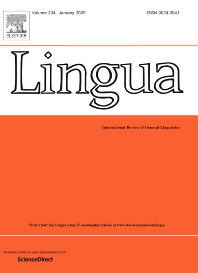【限时资源,期刊全文】Lingua《语言》2019年论文集-共84篇论文(侵删)
1533 阅读 23 下载 2020-06-24 18:14:02 上传 57.08 MB
本篇推送的是SSCI权威期刊——Lingua《语言》2019年论文集,即第217卷-232卷的84篇论文,其中目录可在正文中查看,全文可以点击文末附件列表下载,下载链接即日起三天内有效,失效后可联系小
Lingua《语言》2019年论文集-共84篇论文(侵删)
资料整理:张明辉(微信:zhangxiaojian160408)
(下载链接三天内有效,失效后请联系小编微信索取)

| 卷号 | 论文号 | 论文题目 |
| Vol. 217 | Article 01 | The family of Japanese no-wa cleft construction: A register-based analysis |
| Vol. 217 | Article 02 | A dynamic account of lian…dou in Chinese verb doubling cleft construction |
| Vol. 217 | Article 03 | A cognitive syntactico-semantic analysis of the Croatian verbal prefix uz- |
| Vol. 217 | Article 04 | Factors contributing to the aesthetic attractiveness of metaphors in a complimentary context |
| Vol. 217 | Article 05 | Quality and duration of unstressed vowels in Polish |
| Vol. 217 | Article 06 | ‘Authentic signing equals creative signing’: New perspectives on the enregisterment of creative language use in German Sign Language |
| Vol. 217 | Article 07 | A reply to Malik |
| Vol. 218 | Article 08 | Introduction-Diachronic and synchronic Chinese linguistics: Principles and facts |
| Vol. 218 | Article 09 | Change of neuronal pathways in Chinese speakers with non-fluent aphasia after therapy |
| Vol. 218 | Article 10 | Sino-Korean coda -l and the syllabic structure of Old Sino-Korean |
| Vol. 218 | Article 11 | Whispered Mandarin has no production-enhanced cues for tone and intonation |
| Vol. 218 | Article 12 | The nature of left- and right-dominant sandhi in Shanghai Chinese—Evidence from the effects of speech rate and focus conditions |
| Vol. 218 | Article 13 | Placement events in Zhuang |
| Vol. 219 | Article 14 | Development of grammatical voice marking in Korean: On the causative, middle and passive uses of suffix -i |
| Vol. 219 | Article 15 | The status of Arabic, superdiversity, and language learning motivation among non-Arab expats in the Gulf |
| Vol. 219 | Article 16 | The coding of sex in Spanish nouns |
| Vol. 219 | Article 17 | Refinement of the matched-guise technique for the study of the effect of non-native accents compared to native accents |
| Vol. 219 | Article 18 | Factivity and subject extraction in Jordanian Arabic |
| Vol. 220 | Article 19 | Evidential strategies in receiver-directed talk: The case of English inferential adverbs |
| Vol. 220 | Article 20 | An SFL approach to gender ideology in the sentence examples in the Contemporary Chinese Dictionary |
| Vol. 220 | Article 21 | Slips of the tongue in the Seoul Korean Corpus of spontaneous speech |
| Vol. 220 | Article 22 | The causative–anticausative alternation in Jordanian Arabic (JA) |
| Vol. 220 | Article 23 | Exploiting the Square of Opposition for expressive purposes |
| Vol. 220 | Article 24 | From visual perception to evidentiality: A functional empirical approach to se ve que in Spanish |
| Vol. 221 | Article 25 | A syntactic analysis of Persian deverbal nominals: An exo-skeletal approach |
| Vol. 221 | Article 26 | Syntactic and pragmatic theories of Chinese reflexives |
| Vol. 221 | Article 27 | An integrated dialect analysis tool using phonetics and acoustics |
| Vol. 221 | Article 28 | Acoustic analysis of intonation: Comparison between two dialects of Spanish from the north of the peninsula |
| Vol. 221 | Article 29 | Anglicisms in German media: Exploring catachrestic and non-catachrestic innovations in radio station imaging |
| Vol. 221 | Article 30 | Language Conflict and Language Rights: Ethnolinguistic Perspectives on Human Conflict, William D. Davies, Stanley Dubinsky, Cambridge University Press, Cambridge (2018), 425 pp. |
| Vol. 222 | Article 31 | Hands occupied: Chinese farmers use more non-manual pointing than herders |
| Vol. 222 | Article 32 | The domain of emphasis spread in Arabic: Evidence from Urban Jordanian Arabic |
| Vol. 222 | Article 33 | An acceptability judgment study of 1+1 NN compounds in Chinese |
| Vol. 222 | Article 34 | Translanguaging as trans-identity: The case of ethnic minority students in Vietnam |
| Vol. 222 | Article 35 | Shifting responsibilities: Student e-mail excuses and how faculty perceive them |
| Vol. 222 | Article 36 | Methodological confusions in universal grammar: Reply to Kim |
| Vol. 223 | Article 37 | Word order as an interface between syntax and pragmatics: The case of identifying topics in mixed case-marking patterns in Mandarin Chinese |
| Vol. 223 | Article 38 | Psychological verbs as a vulnerable syntactic domain: A comparative study of Latin and Italian |
| Vol. 223 | Article 39 | Optional ergative marking in Tujia |
| Vol. 223 | Article 40 | Distance and word order between lexical heads and noun dependents in Chinese–English code-switching |
| Vol. 224 | Article 41 | Poi in Japanese Wakamono Kotoba ‘youth language’: A view from attenuation at the speech-act dimension |
| Vol. 224 | Article 42 | When prosody meets syntax: The processing of the syntax-prosody interface in children with developmental dyslexia and developmental language disorder |
| Vol. 224 | Article 43 | Multilingual students’ use of their linguistic repertoires while writing in L2 English |
| Vol. 224 | Article 44 | Can dependency distance and direction be used to differentiate translational language from native language? |
| Vol. 224 | Article 45 | Chunks are components: A dependency grammar approach to the syntactic structure of Mandarin |
| Vol. 225 | Article 46 | “Listisimo para los #XVdeRubi:” Constructing a chronotope as a shared imagined experience in Twitter to enact Mexicanness outside of Mexico |
| Vol. 225 | Article 47 | Translanguaging in an academic setting |
| Vol. 225 | Article 48 | Managing identity in football communities on Facebook: Language preference and language mixing strategies |
| Vol. 225 | Article 49 | Euphemisms and non-proximal manipulation of discourse space: The case of blue-on-blue |
| Vol. 225 | Article 50 | The morphosyntax of numerals ʥi33/ʥĩ35 ‘one’ in Shuhi and implications for the semantics of numerals |
| Vol. 226 | Article 51 | Embedded tense interpretation and sequence of tense in Persian |
| Vol. 226 | Article 52 | South-Asian similatives: A typological perspective |
| Vol. 226 | Article 53 | Ourself and Themself: Grammar as expressive choice |
| Vol. 226 | Article 54 | Dimensions of sociolinguistic distinction in postcolonial ethnic diversity: Folk perceptions of language across Namibia's rural/urban divide |
| Vol. 226 | Article 55 | Voluntary motion events in Uyghur: A typological perspective |
| Vol. 227 | Article 56 | Focus constructions, verb types and the SV/VS order in Italian: An acquisitional study from a syntax–prosody perspective |
| Vol. 227 | Article 57 | The non-native speaker teacher as proficient multilingual: A critical review of research from 2009–2018 |
| Vol. 227 | Article 58 | The compound-phrase divide and the lexicon: Insights from non-lexicalized adjective-noun combinations in German |
| Vol. 227 | Article 59 | Struggling between national pride and personal empowerment: The language ideologies held by Chinese university students towards China English |
| Vol. 227 | Article 60 | In quest of a new identity? Language variation in Sabah |
| Vol. 228 | Article 61 | Eye tracking reveals subtle spoken sentence comprehension problems in children with dyslexia |
| Vol. 228 | Article 62 | The evaluation of unfilled pauses: Limits of the prestige, solidarity and dynamism dimensions |
| Vol. 228 | Article 63 | Socio-psychological salience and categorisation accuracy of speaker place of origin |
| Vol. 228 | Article 64 | The level of explicitation of reference in the translation of medical texts from English into Persian: A case study on basic histology |
| Vol. 229 | Article 65 | Language shift from Forro to Portuguese: Language ideologies and the symbolic power of Portuguese on São Tomé Island |
| Vol. 229 | Article 66 | The experiential aspect of Mandarin Chinese (-guo): Semantics and pragmatics |
| Vol. 229 | Article 67 | The syntax of focus in Caucasian Urum |
| Vol. 229 | Article 68 | Micronarrative: Unit of analysis for quantitative studies of gesture in focus interviews |
| Vol. 229 | Article 69 | Meaning potentials and discourse markers: The case of focus management markers in Persian |
| Vol. 230 | Article 70 | Evaluating objective and subjective frequency measures in L2 lexical processing |
| Vol. 230 | Article 71 | “It has the ability to make the other person feel comfortable”: L1 Japanese speakers’ folk descriptions of aizuchi |
| Vol. 230 | Article 72 | Quantitative linguistics approach to interlanguage development: a study based on the Guangwai-Lancaster Chinese Learner Corpus |
| Vol. 230 | Article 73 | Is a general non-ethnocentric theory of human communication possible? An integrationist approach |
| Vol. 230 | Article 74 | The Spanish future tense and cognitive perspective: Tense, modality, evidentiality and the reflection of the grounding process |
| Vol. 231 | Article 75 | Cumulative usage effects on lexeme-final [s]: probability of being affixed |
| Vol. 231 | Article 76 | The imperfective paradox in a second language: A dynamic completion-entailment test |
| Vol. 231 | Article 77 | A corpus-based study of evidentials in the Turkish Cypriot dialect |
| Vol. 231 | Article 78 | Diaspora varieties of Korean: Morpho-syntactic contrasts in Koryo Mar and Vernacular Yanbian Korean |
| Vol. 231 | Article 79 | A prosodic account of wh-formation in Jordanian Arabic |
| Vol. 232 | Article 80 | Formation of the Modern Chinese clause-taking imperative ni kan ‘you see’: A Conjoining pathway account |
| Vol. 232 | Article 81 | Directionality of linguistic synesthesia in Mandarin: A corpus-based study |
| Vol. 232 | Article 82 | The varieties of verbal irony: a new neo-Gricean taxonomy |
| Vol. 232 | Article 83 | Assessing components of multi-(lingual) competence in young learners |
| Vol. 232 | Article 84 | Review of The grammatical realization of polarity contrast: Theoretical, empirical, and typological approaches, Dimroth, Sudhoff (Eds.) (2018) |
所需积分:0 分
限期开放已结束
表情
图片
附件












